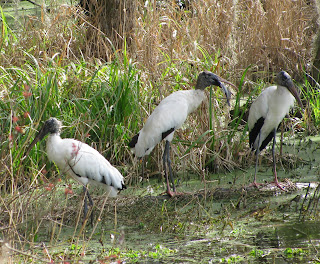We are honored to partner with
North Florida Land Trust.
The North Florida Land Trust conserves scenic, natural, agricultural and open land for the future of Northeast Florida in seven counties by:
- Developing long term land protection strategies
- Promoting private and public funding for land conservation
- Acquiring land and conservation easements
- Stewardship including the restoration of conservation properties
- Promoting a sense of place and a land ethic through activities, education and outreach.
Our protected lands are located throughout northeast Florida. From historic meadows and tidal wetlands to leafy woodlands and inland wetlands, we are stewards of all North Florida's representative habitats. Some of these properties are small or need prior permission from our Executive Director to access them. We rely on visitors and neighbors to be our eyes and ears on Land Trust properties as well as to report bird and wildlife sightings. We want you to care for our properties as much as we do.
Thousands of acres of land and natural habitat in North Florida are being lost every year to development. Only through conservation efforts at every level will we have success in retaining this area's natural beauty: clean water and air; a healthy ecosystem; and our quality of life.
NFLT relies on support from community members with a strong land conservation ethic to provide financial support that makes our work possible. NFLT is a regional land trust that spans seven counties: Baker, Clay, Duval, Flagler, Nassau, Putnam and St. Johns counties.
Our Mission
The Mission of the North Florida Land Trust is to preserve and protect open space in Northeast Florida. Preservation of open space benefits our community by adding to quality of life values for the residents of our community, preserving precious natural habitats and the rural character of Northeast Florida for future generations.
History
Founded in 1999, The North Florida Land Trust has over eleven years experience conserving and protecting lands in North Florida. In all, 130 acres are owned by the North Florida land Trust and over 500 acres are protected by conservation easements. North Florida Land Trust has protected more than 1,100 acres of beautiful, productive and environmentally significant land in and around Northeast Florida.
The North Florida Land Trust is a local, non-governmental, non-profit organization funded largely by membership contributions. The Land Trust works closely with private landowners and other public agencies at all levels of government, nonprofit partners, and foundations. The North Florida Land Trust is a member of the Florida Alliance of Land Trusts and subscribes to the Standards and Practices of the national Land Trust Alliance.
Best Standards and Practices
Through the adoption of and adherence to the Land Trust Alliance's Best Standards and Practices, our organization has reached a high level of professionalism. This is essential for the responsible operation of a Land Trust and ensures that a land trust operates legally, ethically and in the public interest. It also establishes a sound program of land transactions and stewardship.
Governance
The North Florida Land Trust is governed by a highly involved Board of Directors and is enthusiastically supported by over 500 members. The day-to day operations of the Land Trust are overseen by Bonnie Barnes, our Executive Director.
I am delighted to partner with North Florida Land Trust for our Six Artists Six Prairies project.
Scott Hiestand









